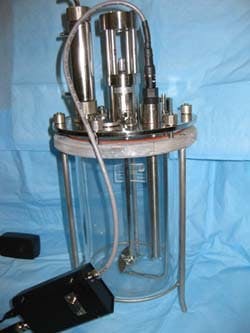This trend of decreasing glucose consumption and lactate production rates with decreasing culture pH was also observed in experiments done with HeLa cells [4] and hybridoma cells [5,6]. One study found that as the culture pH decreased from 7.6 to 6.8, hybridoma cells exhibited a decrease in growth rate, as well as in glucose consumption and lactate production rates [6]. This is in contrast to the observation on HL60 cells, where as the culture pH decreased from 7.4 to 7.0, the HL60 growth rate was largely unaffected, while a 20-40% decrease in glucose consumption and lactate production rates was observed.Possible reasons for the observed overall better yields (i.e., more cells per mole of glucose) could be due to utilization of a higher percentage of other nutrients at lower pH, a decrease in metabolic energy requirements (including cell maintenance), or more likely, complex events involving several metabolic and membrane processes. Clearly, pH is an important bioprocessing parameter in the large-scale culture of mammalian cells, as it affects cell physiology, protein expression and quality, and cell differentiation.Glycosylated ProductsProtein glycosylation is of critical importance in the efficacy of therapeutic proteins. N-linked glycosylation of the protein therapeutic with N-acetylneuraminic acid (aka sialic acid), a modification that is closely linked to circulatory half-life, is a typical marker for product quality assessment. Glycosylated therapeutics currently on the market includes blockbusters such as Avastin, Enbrel, Erbitux and Herceptin, to name a few. Obtaining a consistent glycoform profile in production is critical due to regulatory concerns. Complete characterization of a therapeutic molecule typically includes thorough characterization of its carbohydrate structures using a combination of enzymatic procedures, liquid chromatography and mass spectrometry.Mammalian expression systems, particularly CHO cells, are the preferred method for producing glycoproteins at commercial scale, because their innate processing machinery, including protein glycosylation, closely resembles that in humans. However, the cell type, culture process and media can have critical effects on the glycosylation profile. Most of the effects are impacted via the metabolic process that occurs within the host cells, which is critically dependent on the pH. For example, ammonium ions, which can accumulate as a byproduct of glutamine and asparagine metabolism, can drive an increase in intracellular pH and a decrease in terminal sialylation which, in turn, can dramatically impact pharmacokinetics and efficacy [7]. Bioreactor pH has also been found to affect protein glycosylation. For example, in hybridoma cells, shifts in pH can affect both the galactosylation and sialylation of the resulting monoclonal antibody. Increasing the pH to 7.4 and above appears to promote the production of digalacto-complex-type glycans in HEPES buffered cultures, while lower pH promotes the formation of mono- or agalacto-type-complex glycans [8]. The proportion of acidic isoforms of Erythropoietin increase with decreasing culture pH with an optimal range of 6.8-7.2 favoring sialylation. Of note, however, is that the effect of pH is not always consistent, as a higher pH has the opposite effect with polysialic acid attached to neural cell adhesion molecules expressed on CHO cell surfaces [9].Stem Cell ProcessesWith the growing importance of stem cells as potential therapeutic agents, interest in understanding and optimizing stem cell processing is increasing significantly. Almost all mammalian cell culture expansion cultures are run at fairly standard conditions (pH 7.4; 20% oxygen, 5% carbon dioxide and 37C), but different stem cell cultures proliferate and differentiate at different optima. For instance, higher pH (pH 7.6) was found to enhance the differentiation and maturation of megakaryocytic progenitors and, also, to favor erythroid differentiation [10]. In contrast, granulopoeisis is optimal at lower pH (pH 7.21), which enhances granulocyte colony-stimulating factor receptor (G-CSFR) expression and granulocyte proliferation and differentiation [11]. Unless pH is properly controlled, problems with cellular quality and/or uniformity may result. Effective pH control is not always easy to achieve, because pH gradients can result from spatial inhomogeneity in the cell culture. In addition, the extracellular pH may vary dramatically depending upon the culture system, especially as the cell density increases. Recent studies have shown that, within six hours of feeding, Chinese hamster fibroblasts in T-flasks, had a local pH of 6.5, even though the bulk pH remained at 7.6. Clearly, the use of gentle agitation in bioreactor tanks can provide greater homogeneity within the extracellular milieu.Further, in a hollow-fiber reactor system, researchers found gradients in nutrient concentrations, which could eventually lead to gradients in pH and dissolved oxygen [12]. As this research suggests, understanding the effects of variations in culture pH on cell functions and properties is essential for each new culture.Protein AggregationCareful pH control can also help reduce protein aggregation, commonly found during biopharmaceutical manufacturing. Protein aggregation can take many forms. For example, reversible protein aggregation (e.g., as occurs in a monoclonal antibody to VEGF) results from relatively weak covalent protein interactions that shifts the equilibrium between monomer and higher order forms. This equilibrium can be affected by a simple change in extracellular pH [13].Sensor Function and DriftOne additional challenge for the pH measurement in bioprocessing is the cleaning process. The fermentor or bioreactor must be sterilized prior to the start of either process to ensure that no cross-batch or unwanted microbial contamination is present. In addition, pH sensors undergo a two-point calibration using buffer solutions. Residual buffer chemicals must be removed prior to start of the batch. The Clean in Place system (CIP) is used prior to Steam in Place (SIP). Exposure to high temperature steam and rapid thermal shock during SIP can significantly affect the pH sensor’s function.Different culture batches will have different optimal setpoints, and the pH levels may change when the batch moves to different phases. With classical glass pH electrodes, a number of factors may result in pH values drifting, diminishing confidence in measurements. These include include fouling or coated junctions on the reference electrode. Two-point buffer calibration cannot be performed with sensors that are mounted in a vessel that has already been sterilized, since the probe cannot be removed to recalibrate with buffer standards. Therefore, the net result is to perform more frequent off-line pH tests and then standardize the on-line measurement to the off-line values (one-point calibration). This is more pronounced in longer batches where the well-trained personnel must be on site to properly perform the tasks. Once a therapeutic protein has been produced from a cell culture (or other expression system), it has to be further purified to reduce or remove host cell proteins, viruses and process-related impurities. To purify and concentrate the required protein, orthogonal purification techniques are used, which exploit differences in affinity, charge, size or other properties that distinguish the desired from undesired product. The protein will experience a wide range of pH, ionic strength and concentration during this process. While these are all critical, they must also be closely controlled to prevent the loss of product from processes such as aggregation of the protein.Where QbD Fits InThe implementation of process analytical technology (PAT) to facilitate biopharmaceutical Quality by Design (QbD) is critical to maintaining consistency in critical environmental parameters such as pH. In the past 10 years, protein expression titers have increased 1000 times to the g/L range. Downstream bioprocessing involving buffer preparation and delivery has had to increase proportionally to keep pace. With the development of more sophisticated technologies and procedures to produce and deliver industrial quantities of buffers with the requisite accuracies, feedback control of critical parameters such as pH becomes more important. In the protein purification and separation process, the use of ion-exchange columns is a critical step. These function through the separation of proteins based on their net surface charge at a specific pH with separation based on the reversible interaction between a charged protein and an oppositely charged chromatographic medium. Key considerations are the following:• Protein with 0 net charge: pI = pH will not bind to a charged medium • Protein with pI < pH will bind to a positively charged medium or anion exchanger • Protein with pI > pH will bind to a negatively charged medium or cation exchangerElution of the proteins can occur using either a continuous or a stepwise salt or pH gradient. pH gradient separation requires 1-2 pH unit change to separate two proteins of different charge. The titration curve between acid and base, whether strong or weak, however, is not linear. This obviates the use of pH gradients during a chromatographic run to resolve proteins with similar pI.Typically, the blending of a weak acid such as acetic acid and weak base such as ammonium hydroxide results in a sigmoidal titration curve with a steep rise in pH from pH 6.5 to pH 9 over an extremely short period of time when using mass-flow. However, it has been demonstrated that using a PAT-based system involving the careful feedback-control of the acid delivery can generate a linear pH gradient that could promote more efficient chromatographic separation [14].In summary, pH measurement plays a significant role in all aspects of biopharmaceutical production. The accurate control of pH is necessary for maintaining high quality standards mandated under cGMP. With the introduction of single-use manufacturing technologies has come a new challenge to the manufacturers of pH sensors. Newer technologies are being introduced and must keep improving to keep pace with rapidly evolving demands in the industry.About the AuthorJim Wilkins joined Sensorin in 2009 as Chief Technology Officer. Previously, he served as Director of Technology Assessment and Licensing at Genentech; as Professor of Chemical Engineering at Yale; and as Vice President of Process Development and Manufacturing at Alexion Pharmaceuticals. Dr. Wilkins earned his B.A. at the University of Texas at Austin; his Ph.D. at the University of Tennessee; and was a post-doctoral fellow and faculty member in biophysics at the Johns Hopkins University.References1. Naciri, M., Kuystermans, D., and Al-Rubeai, M. (2008) Cryotechnology, 57(3), 245-250.2. Wayte, J. http://www.lonza.com/group/en/company/tradefairs/presentations.-ParSys-0004-DownloadFile.tmp/GS-NS0%20process%20improvements.pdf3. McDowell, C.L ., Papoutsakis, E.T. (1998), Biotechnol. Prog., 14, 567-572.4. Barton, M.E. (1971), Biotechnol. Bioeng. 13, 471-492.5. Miller, W.M., Blanch, H.W., Wilke, C.R. (1988), Biotechnol. Bioeng. 32, 965-977.6. McQueen, A. & Bailey, J.E. (1991) Bioprocess Eng. 6, 49-61.7. Thorens, B., Vassalli, P. (1986) Nature, 321, 618-620.8. Muthing, J., Kemminer, S.E., Conradt, H.S., Sagi, D., Nimtz, M., Karst, U. and Peter-Katalinic, J. (2003) Biotechnol, Bioeng. 83, 321-334.9. Zanghi, J.A., Schmelzer, A.E., Mendoza, T.P., Knop, R.H., and Miller, W.M. (1999) Biotechnol. Bioeng 65, 182-191.10. McAdams, T.A., Winter J.N., Miller, W.M., Papoutsakis, E.T. (1998), Br. J. Hematol., 103, 317-325.11. Hevehan, D.L., Papoutsakis, T.E., and Miller, W.M. (2000) Exp. Hematol., 28, 267-275.12. Heath and Belfort (1987) Adv. Biochem. Eng. Biotechnol.,34, 1-31.13. Cromwell, M.E.M., Hilario, E. and Jacobson, F. (2006), AAPS Journal, 8(3), E572-E579.14. Li, M., Kamut, V., Yabe, H., Jariwala, S., & Miyabayashi, T. (2010) Pharmaceut. Tech. 34, s18-s22.






